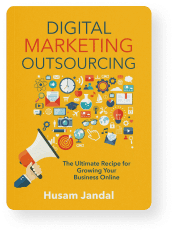 “Artificial intelligence” (AI), “automation,” and “influencer marketing” are some of the biggest buzzwords of our time. Businesses are often in such a hurry to adopt them that they forget each has its limitations. But, in order to maximize their value and leverage them in a way that boosts your digital marketing results, it’s essential to understand what these limitations are and how to work with the tools effectively. I’ll walk you through how to do that in this guide.
“Artificial intelligence” (AI), “automation,” and “influencer marketing” are some of the biggest buzzwords of our time. Businesses are often in such a hurry to adopt them that they forget each has its limitations. But, in order to maximize their value and leverage them in a way that boosts your digital marketing results, it’s essential to understand what these limitations are and how to work with the tools effectively. I’ll walk you through how to do that in this guide.
The Hype About Marketing Automation: Debunked
Marketing automation is one of the most prized tools in the digital marketing world today. Around half of all businesses use it to some degree, according to Forrester. It has the potential to help your business nurture leads, deliver timely messages, and move prospects closer to a sale with less manual effort. There’s data to back this up. For instance, a typical marketer saves 25 hours each week through automation, Zapier reports. Meanwhile, the average ROI for an automated process is 500 percent, Userpilot notes.
Clearly, marketing automation strategies can have a powerful impact. However, there are lots of misconceptions about how it works and the results you can achieve. Let’s take a look at some of these myths.
Hype: You Can Automate Tasks and Leave Them on Autopilot
It’s often thought that because automation operates based on a set of rules, you can “set it and forget it.”
Reality: Automation Requires Oversight
This is one of the first places we see automation limitations creep in. Systems need constant oversight, testing, and refinement to stay effective for many reasons.
- Changing Customer Behavior: Market needs shift constantly. If your automation is based on outdated assumptions, you risk becoming irrelevant.
- Platform Updates: Tools evolve, and features change. Regular audits are necessary to ensure everything functions as intended.
- Message Fatigue: Even the best emails and offers lose effectiveness over time. Automation campaigns must be refreshed periodically to maintain engagement.
Hype: Automation Can Personalize Customer Experiences on Its Own

It’s absolutely true that automation platforms can trigger emails based on customer behavior. They can also segment audiences based on basic demographics or actions taken. But, it’s a little more nuanced than that.
Reality: Human Input is Essential
The kind of personalization that builds real relationships still requires human creativity and strategy. Without it, you miss out on:
- Nuanced Understanding: Automation works from data points, not emotions. A machine might know a customer clicked a link, but it does not understand why they clicked.
- Storytelling: Real connections are built through relatable narratives and authentic tone. Automation tools cannot craft that emotional bridge on their own.
- Adaptability: Customers often behave unpredictably. Humans are better equipped to pivot messaging based on subtle shifts that automation might miss.
Hype: Automation Always Saves Time and Money
As mentioned earlier, automation saves a typical marketer 25 hours per week. That gives you almost half your time back to apply to strategy and other high-value areas. However, this doesn’t necessarily mean that every deployment is a win.
Reality: Automation Can Become Inefficient
Businesses that approach automation without a clear strategy often find themselves burning more time and budget than before due to:
- Bad Data Inputs: If your database is outdated or filled with errors, automation spreads mistakes faster.
- Complex Processes: Over-engineered workflows confuse both your team and your customers.
- Lack of Testing: If campaigns are launched without proper QA, they can misfire, creating more manual work to fix problems.
Hype: Automation Fixes Broken Processes
Marketing automation is sometimes treated as if it’s a magic wand that can transform disjointed or broken processes into a machine designed for conversion.
Reality: Automation Cannot Fix Underlying Issues
If your lead nurturing is weak, your sales handoff is sloppy, or your customer experience is disjointed, automation will not fix it. It will simply speed up the rate at which you lose prospects. Before investing in marketing automation, ensure your underlying workflows are solid. Otherwise, you are just making bad results happen faster due to:
- Poor Foundations: Automation amplifies what already exists. If your process is flawed, it will just automate a bad experience.
- Missing Strategy: Without a clear customer journey mapped out, automation tools have no blueprint to follow.
- No Feedback Loops: Strong processes require built-in checkpoints to evaluate success. Automation alone cannot diagnose where things go wrong.
The Hype About AI: Debunked

Artificial intelligence has taken marketing by storm. It is prized for its ability to quickly generate content ideas, identify trends, and streamline repetitive tasks. Businesses often turn to AI to boost efficiency, deliver faster results, and keep pace with the digital landscape.
However, the reality behind AI often gets lost in the excitement. Many AI marketing myths have set unrealistic expectations, leading to costly mistakes. If you want to use AI wisely, you must understand the limitations of AI in business and recognize where human expertise remains essential.
Hype: AI Creates All Your Content Instantly
AI tools are celebrated for their speed and efficiency. They can draft blog posts, social media updates, and product descriptions in minutes. It’s tempting to think that AI can handle all your content needs on its own.
Reality: AI-Generated Content Lacks Originality, Brand Voice, and Context
While AI produces content quickly, the quality of AI-generated content often falls short without human intervention. Key limitations include:
- Surface-Level Understanding: AI pulls from patterns in existing material. It cannot invent truly original ideas or thought leadership.
- Brand Voice Misalignment: Automated writing tends to sound generic and often misses the nuances that make your brand unique.
- Context Gaps: AI lacks the ability to factor in current events, customer sentiment, or subtle industry trends unless specifically trained to do so.
Hype: AI Gives You Custom Marketing Strategies
Because AI platforms can process massive datasets and generate recommendations, it is often assumed that they can create tailored marketing strategies for your business.
Reality: AI Provides Data, But Not Deep Business Insights
AI can point you toward trends, but it cannot replace the strategic thinking that goes into building a strong marketing plan. This comes down to:
- Lack of Strategic Thinking: AI identifies patterns but does not understand business priorities, competitive pressures, or brand positioning.
- Context Blindness: AI suggestions are based on general information. They are not informed by your internal goals, resources, or customer relationships.
- Missed Emotional Drivers: Successful strategies are built around human emotions and storytelling. AI cannot craft these connections authentically.
Hype: AI Designs Perfect Graphics Without a Designer
With AI image generators and design templates available, it can seem like professional design is no longer necessary.
Reality: AI-Generated Visuals Still Require Human Refinement
AI can speed up basic design work, but it cannot replace creative professionals. It falls short regarding:
- Visual Consistency: AI often struggles to maintain brand color palettes, typography, and cohesive style across all assets.
- Error Checking: AI may generate warped images, off-center layouts, or details that don’t align with brand guidelines.
- Creative Nuance: Great design tells a story. AI can mimic structure, but it does not understand symbolism, mood, or cultural context.
Hype: AI Thinks Like a Human and Solves Your Marketing Challenges
With its ability to process information quickly, AI is sometimes seen as a creative problem solver.
Reality: AI Lacks Critical Thinking and Emotional Intelligence
At its core, AI is built on pattern recognition, not human understanding. Major limitations include:
- No Critical Judgement: AI cannot evaluate complex trade-offs, weigh ethical concerns, or anticipate long-term consequences.
- Emotional Disconnect: AI lacks empathy, loyalty, and trust. It cannot build emotional relationships with customers.
- Rigid Logic: When presented with incomplete or conflicting information, AI cannot reason through it the way a human strategist would.
The Hype About Influencer Marketing: Debunked
Influencer marketing has earned a permanent seat at the digital strategy table. It is prized for its ability to extend brand reach, build trust quickly, and create authentic-looking endorsements through partnerships with popular personalities.
Today, more than 80 percent of marketers are using influencer marketing, according to Social Media Today. Plus, brands bring in nearly $6 for each $1 spent, Influencer Marketing Hub reports.
It is easy to understand the excitement. However, if you want your influencer marketing program to drive real results, you must recognize the limitations. Blindly believing in the hype can lead to wasted budget and missed opportunities.
Hype: Influencers Guarantee Sales Because They Have Huge Followings
It is tempting to think that tapping into an influencer’s massive audience will automatically translate into more sales for your business.
Reality: Reach Does Not Equal Conversion
Even if an influencer has a large follower count, it doesn’t necessarily mean they have a highly engaged and buying audience. Roadblocks here include:
- Audience Quality: Some influencers have inflated follower counts due to bots or inactive accounts.
- Misaligned Audiences: Even real followers might not match your target demographic or have any interest in your products.
- Passive Engagement: Liking a post is easy. Taking out a credit card to make a purchase is a much bigger leap.
Hype: Sponsored Content Works Just as Well as Organic Recommendations
Brands often assume that once an influencer mentions their product, their audience will trust it immediately, regardless of the context.
Reality: Consumers Are Increasingly Skeptical of Paid Promotions
Today’s audiences are savvy. They can spot a sponsorship a mile away, and they do not always respond positively. Key challenges include:
- Trust Erosion: If an influencer promotes too many products, their credibility takes a hit.
- Overly Scripted Messaging: Audiences notice when endorsements sound forced or unnatural, reducing authenticity.
- Sponsorship Saturation: In highly commercialized feeds, brand messages can easily get lost or ignored.
Hype: Influencers Can Replace a Brand’s Own Marketing Efforts
With enough influencer partnerships, some brands believe they no longer need to invest in their own marketing assets or strategies.
Reality: Influencer Marketing Should Complement, Not Replace, a Real Strategy

Influencers are amplifiers, not foundations. This is due to:
- Limited Control: You cannot fully control how an influencer presents your brand, which creates risks.
- Short-Term Focus: Influencer campaigns are often campaign-specific and do not necessarily build long-term brand equity.
- Lack of Owned Assets: Without your own strong website, email list, and content, you are relying entirely on borrowed audiences.
Hype: Brand Authenticity Comes from People, Not Algorithms
Because influencer marketing involves real people rather than automated ads, it is often seen as a shortcut to instant authenticity.
Reality: Influencer Partnerships Only Work When They Align with a Brand’s Values
An influencer’s popularity alone cannot manufacture real brand trust. True authenticity requires alignment. Let’s go over a few considerations.
- Brand Fit: Collaborations must feel natural and reflect your brand’s core identity.
- Audience Expectations: Followers can tell when an endorsement feels out of character for the influencer they trust.
- Reputation Risk: Partnering with someone who does not share your values can damage your brand faster than it helps.
How to Strike the Right Balance Between Tech and Strategy
Artificial intelligence, automation, and influencer marketing are powerful tools when used wisely. Let’s take a look at how to do that.
Automate the Repetitive, But Keep the Human Touch Where It Matters
Automation can create efficiency, but it cannot build relationships on its own.
- Automate Routine Communications: Transactional emails, reminders, and simple nurturing sequences are great candidates for automation.
- Protect High-Value Touchpoints: Personal outreach in sales conversations, major milestones, or customer support should stay human.
- Monitor Customer Experience: Regularly review your automated flows to ensure they still feel natural and personal where needed.
Use AI for Efficiency, Not for Replacing Strategy
AI is at its best when it supports decision-making, rather than trying to lead.
- Accelerate Routine Tasks: Use AI to draft initial content ideas, identify trends, or automate basic customer interactions.
- Inform, Not Dictate: Let AI suggest options, but keep humans in charge of interpreting insights and choosing the right path.
- Stay Critical: Always review AI-generated outputs carefully to ensure they align with brand goals and ethical standards.
Work with Influencers as Brand Partners, Not Just Ad Placements
Influencer marketing delivers its strongest returns when it supports your brand story rather than replacing it. A few tips to keep in mind while developing your influencer marketing strategy are covered below.
- Prioritize Brand Alignment: Choose influencers whose values, voice, and audience naturally fit your brand.
- Build Long-Term Relationships: Collaborations over time feel more authentic to audiences and deepen brand credibility.
- Integrate Influencer Content: Use influencer-created content to enhance your own marketing channels, not just theirs.
Get Help Building a Balanced Digital Marketing Strategy
As someone who has been working in digital marketing since before it even had a name, and while programs like Google Search were in their infancy, I’ve seen countless trends and tools emerge. There are always some growing pains involved as they’re incorporated into marketing strategies. Understanding their limitations and structuring your strategy with them in mind helps you maximize the value while avoiding the drawbacks. If you want to modernize your digital marketing strategy, but aren’t sure where to start, contact me for a complimentary consultation.
FAQs on the Limitations of AI, Automation, and Influencer Marketing
Can marketing automation replace a human marketing team?
No, marketing automation can handle repetitive tasks like email sequencing and lead scoring, but it cannot replace the need for strategic planning, relationship building, or creative storytelling. Automation is a tool that enhances efficiency, not a substitute for the human skills that drive marketing success.
Why does influencer marketing sometimes fail?
Influencer marketing fails when brands prioritize reach over alignment. If the influencer’s audience does not match the brand’s target market, or if the partnership feels forced, the campaign will not resonate. Authenticity, audience trust, and genuine brand fit are essential for influencer marketing to work.
How reliable is AI-generated content for brand marketing?
AI-generated content can be a useful starting point, but it often lacks originality, nuance, and brand consistency. Without human editing and strategy, AI-produced materials can sound generic or off-brand. Businesses should use AI to streamline production, not as a replacement for authentic brand storytelling.
What parts of the customer experience should never be automated?
High-value, emotional, or complex customer interactions should never be automated. This includes handling complaints, resolving sensitive issues, and delivering personalized support. These touchpoints require human empathy, judgment, and flexibility, which automation cannot replicate. A human touch strengthens customer trust and loyalty over time.
Does a large influencer following guarantee better sales?
No, a large following does not guarantee sales. Engagement quality matters far more than audience size. Many influencers have inflated numbers or followers outside your target market. Successful influencer marketing depends on audience alignment, trust, and genuine enthusiasm for the brand being promoted.
What are the risks of relying too much on marketing automation?
Over-relying on automation can lead to impersonal customer experiences, overlooked errors, and brand inconsistency. If workflows are poorly designed or data is bad, automation will magnify problems rather than solve them. Automation should support a thoughtful strategy, not operate independently of it.
How do AI marketing myths hurt business growth?
AI marketing myths create unrealistic expectations. Believing AI can develop strategies, personalize relationships, or replace creativity often leads to shallow campaigns and wasted resources. Businesses that understand AI’s true role as a support tool, not a strategist, build stronger, more sustainable growth.
Can influencers replace a company’s own marketing strategy?
No, influencers are amplifiers, not replacements. They can boost brand visibility and credibility, but should support a broader marketing plan. Without a strong internal strategy and owned channels, businesses risk becoming dependent on third parties and missing opportunities to build lasting brand equity.
How can businesses balance technology and human connection in marketing?
Businesses should use technology to handle routine tasks and provide insights, but maintain human involvement where relationships, strategy, and creativity matter most. Blending efficiency with authentic customer interactions ensures that marketing efforts are scalable without losing the trust and emotional connections that drive loyalty.


































































